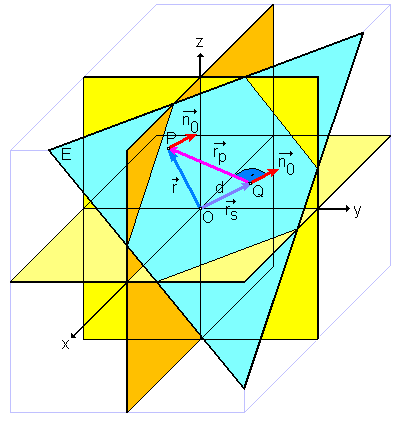Hesse normal form on:
[Wikipedia]
[Google]
[Amazon]
 The Hesse normal form named after
The Hesse normal form named after
 In this diagram, ''d'' is the distance from the origin. Because holds for every point in the plane, it is also true at point ''Q'' (the point where the vector from the origin meets the plane E), with , per the definition of the
In this diagram, ''d'' is the distance from the origin. Because holds for every point in the plane, it is also true at point ''Q'' (the point where the vector from the origin meets the plane E), with , per the definition of the
Otto Hesse
Ludwig Otto Hesse (22 April 1811 – 4 August 1874) was a German mathematician. Hesse was born in Königsberg, Prussia, and died in Munich, Bavaria. He worked mainly on algebraic invariants, and geometry. The Hessian matrix, the Hesse nor ...
, is an equation used in analytic geometry, and describes a line in or a plane in Euclidean space
Euclidean space is the fundamental space of geometry, intended to represent physical space. Originally, that is, in Euclid's ''Elements'', it was the three-dimensional space of Euclidean geometry, but in modern mathematics there are Euclidean ...
or a hyperplane in higher dimensions.John Vince: ''Geometry for Computer Graphics''. Springer, 2005, , pp. 42, 58, 135, 273 It is primarily used for calculating distances (see point-plane distance In Euclidean space, the distance from a point to a plane is the distance between a given point and its orthogonal projection on the plane, the perpendicular distance to the nearest point on the plane.
It can be found starting with a change of varia ...
and point-line distance In Euclidean geometry, the distance from a point to a line'' is the shortest distance from a given point to any point on an infinite straight line. It is the perpendicular distance of the point to the line, the length of the line segment which join ...
).
It is written in vector notation as
:
The dot indicates the scalar product
In mathematics, the dot product or scalar productThe term ''scalar product'' means literally "product with a scalar as a result". It is also used sometimes for other symmetric bilinear forms, for example in a pseudo-Euclidean space. is an alge ...
or dot product
In mathematics, the dot product or scalar productThe term ''scalar product'' means literally "product with a scalar as a result". It is also used sometimes for other symmetric bilinear forms, for example in a pseudo-Euclidean space. is an alge ...
.
Vector points from the origin of the coordinate system, ''O'', to any point ''P'' that lies precisely in plane or on line ''E''. The vector represents the unit
Unit may refer to:
Arts and entertainment
* UNIT, a fictional military organization in the science fiction television series ''Doctor Who''
* Unit of action, a discrete piece of action (or beat) in a theatrical presentation
Music
* ''Unit'' (a ...
normal vector of plane or line ''E''. The distance is the shortest distance from the origin ''O'' to the plane or line.
Derivation/Calculation from the normal form
Note: For simplicity, the following derivation discusses the 3D case. However, it is also applicable in 2D. In the normal form, : a plane is given by a normal vector as well as an arbitrary position vector of a point . The direction of is chosen to satisfy the following inequality : By dividing the normal vector by itsmagnitude
Magnitude may refer to:
Mathematics
*Euclidean vector, a quantity defined by both its magnitude and its direction
*Magnitude (mathematics), the relative size of an object
*Norm (mathematics), a term for the size or length of a vector
*Order of ...
, we obtain the unit (or normalized) normal vector
:
and the above equation can be rewritten as
:
Substituting
:
we obtain the Hesse normal form
:
Scalar product
In mathematics, the dot product or scalar productThe term ''scalar product'' means literally "product with a scalar as a result". It is also used sometimes for other symmetric bilinear forms, for example in a pseudo-Euclidean space. is an alge ...
:
The magnitude of is the shortest distance from the origin to the plane.
References
External links
*{{MathWorld, title=Hessian Normal Form, urlname=HessianNormalForm Analytic geometry